Portland, Oregon has always been a city of bridges. From its early beginnings on the western bank of the Willamette River, settlers recognized the need for transportation across the river. At first, steamboats and ferries filled this need, but it wasn’t enough. For Portland to grow beyond the western banks of the Willamette River, it needed faster, cheaper transportation across not just the Willamette River but also the Columbia River. Come explore Portland’s original bridges through antique postcards from long ago.
This collection of antique postcards took about a year to collect. It doesn’t represent every bridge in Portland, but a good number of the original bridges. If a bridge isn’t listed it’s because I don’t have a postcard of it. (If you know of a Portland bridge postcard that I do not have, leave me a comment below. I’d be interested in seeing it.)
1887/1905/1958 – Morrison Street Bridge
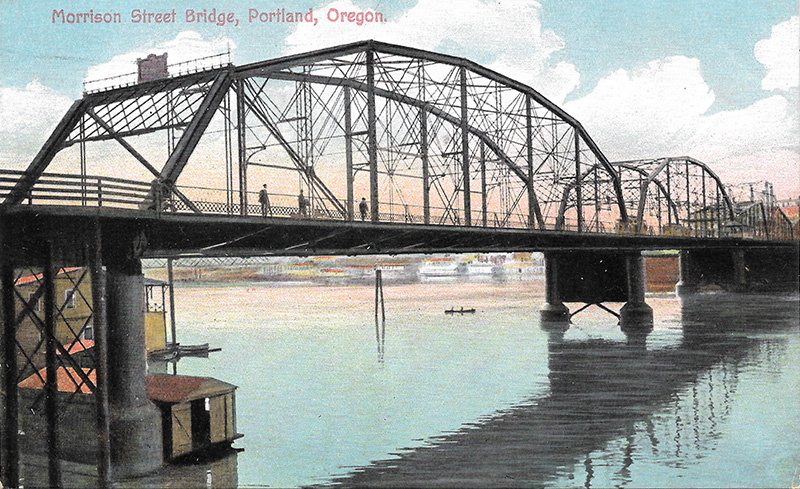
Postcard details: Full color, no border, divided back, unused, domestic 1 cent,
made in Germany, published by Portland Postcard Company.
1887 – Morrison Street Bridge No. 1
The first bridge that Portland residents needed was a bridge to the eastern side of the Willamette River. This would in effect double the size of the Portland Harbor and enable growth to the east. Now wharfs and supporting businesses could be built on the eastern side of the Willamette as well. The first bridge to be built across the Willamette River in Portland was the first Morrison Street Bridge which opened to the public on April 9, 1887. It was a wooden truss swing-span bridge and at the time it was the longest bridge west of the Mississippi. Unfortunately, it was severely damaged.
In 1904, the bridge was struck by a steamer carrying lumber. The boat knocked one of the spans three feet out of alignment. Although the span was put back into place, the bridge was considered unsafe after that. A new bridge would have to be built.
1905 – Morrison Street Bridge No. 2
Construction on the second Morrison Street Bridge started in 1904. It was opened to the public on January 16, 1905. This time the bridge was built of steel and cost less than $400,000.
1958 – Morrison Street Bridge No. 3
The third Morrison Street Bridge, the one we use today, was completed in May of 1958. It’s 3700 feet long and is a Chicago-type double-leaf bascule bridge. A bascule bridge is another name for a draw bridge. It has 6 lanes supporting 50,000 vehicles crossing it every day. A unique feature of the bridge is that it has a system of LED lights that can illuminate the bridge piers in a variety of changing colors.
1910 – Hawthorne (Madison) Bridge
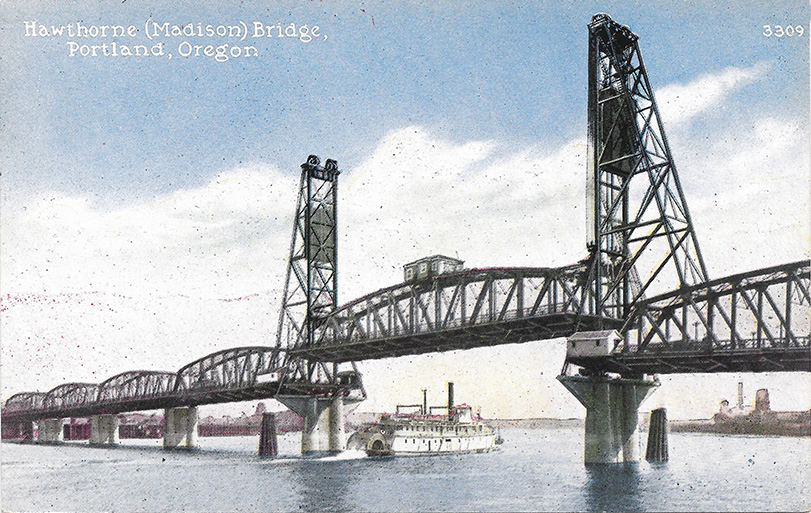
Postcard details: Full color, no border, divided back, unused, domestic 1 cent,
made in Germany, no postage requirement
Opened December 19, 1910, the Hawthorne Madison bridge was built to replace the fire damaged, wooden Madison Street Bridge No. 2. Both Madison Street bridges were swing-bridges and the Hawthorne (Madison) bridge is a vertical-lift bridge. It was one (Interstate Bridge is another) of the nation’s first vertical-lift bridges and is now the oldest operating vertical-lift bridge in the country. During construction the bridge was still being called the Madison Street bridge. Although the bridge was made of steel, to save costs the bridge’s deck was made of wood. One year later bridge improvements were added but the wooden deck still wasn’t upgraded to steel. That turned out to be a costly mistake.
Subscribe to my blog for new articles and a chance to win an authentic, antique map!
In 1914 the Hawthorne Bridge caught on fire. The fire quickly spread to the lift section. The lift section became unbalanced and the counter weights came crashing down onto the bridge. All the damage was repaired but the bridge still featured a wooden deck until 1945.
1912 – Steel Bridge
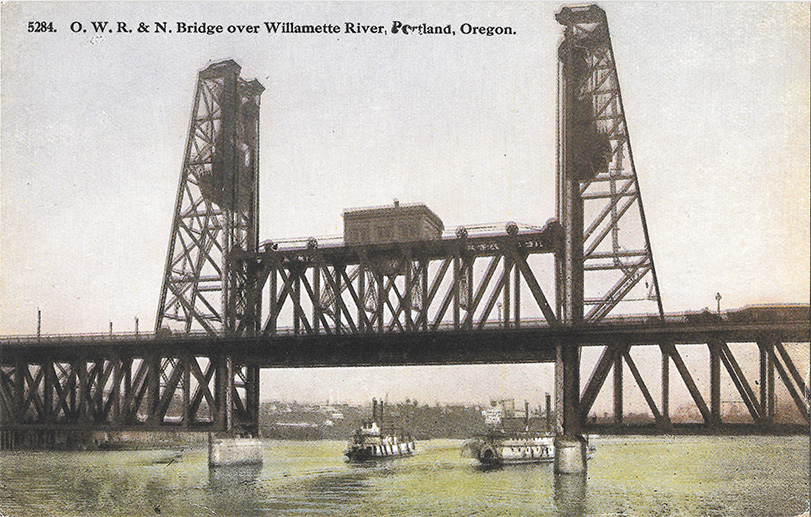
Postcard details: Full color, no border, divided back, tinted, unused, no postage requirement
Originally known as the O.W.R.&N. Bridge over the Willamette, the Steel Bridge opened to traffic in 1912. It cost $1.5 million dollars to build and is a through-truss double-deck bridge that crosses the Willamette River in downtown Portland. It’s the second oldest vertical lift bridge still in operation in the United States. It’s a very unique looking bridge with a lot of character. Travel Portland says the Steel Bridge “rises like an epic-scale erector set over the Willamette River.”
1913 – Broadway Bridge
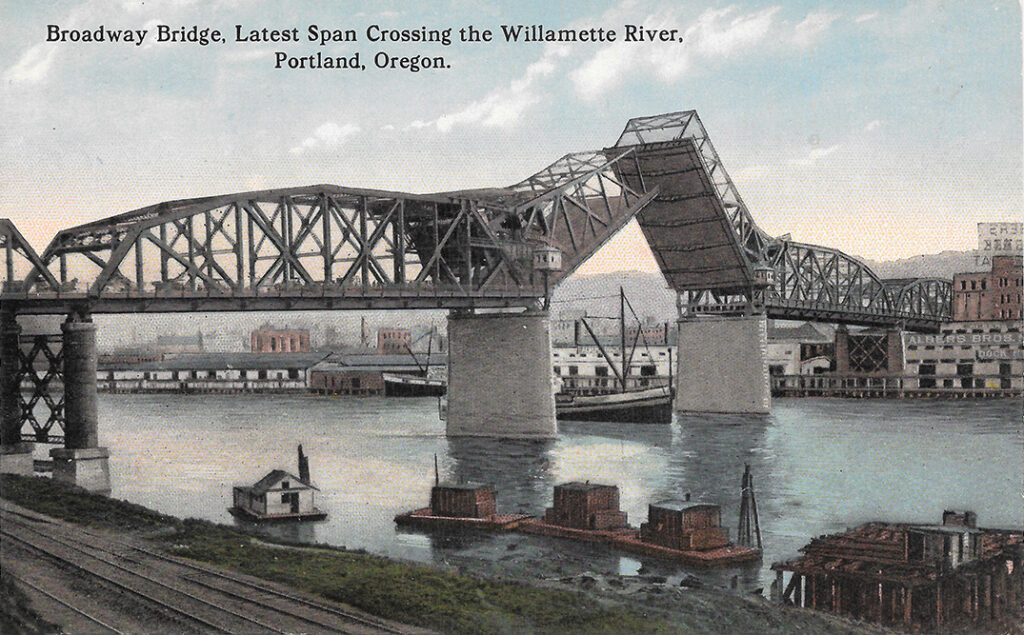
Postcard details: Full color, no border, divided back, domestic 1 cent, unused, published by
Louis Scheiner, Portland, Oregon.
The Broadway Bridge opened to the public on April 22, 1913, at a cost of $1.6 million. It is a Rall-type bascule bridge crossing the Willamette river. A Bascule bridge is another name for a draw bridge. It uses a counterweight to lift a span of the bridge to allow boat traffic underneath. The Broadway Bridge was Portland’s first bascule bridge. It is the longest span of its bascule design type on the world. In 2006, about 30,000 vehicles a day cross the Broadway Bridge. Originally painted black, the Broadway Bridge was repainted “Golden Gate” red in 1963, after an architect suggested each bridge have it’s own color. Streetcar service ran from when the bridge opened until 1940. Construction work to reinstall streetcar tracks began in 2010 with streetcar service across the bridge resuming in 2012.
1917/1958 – Interstate Bridge
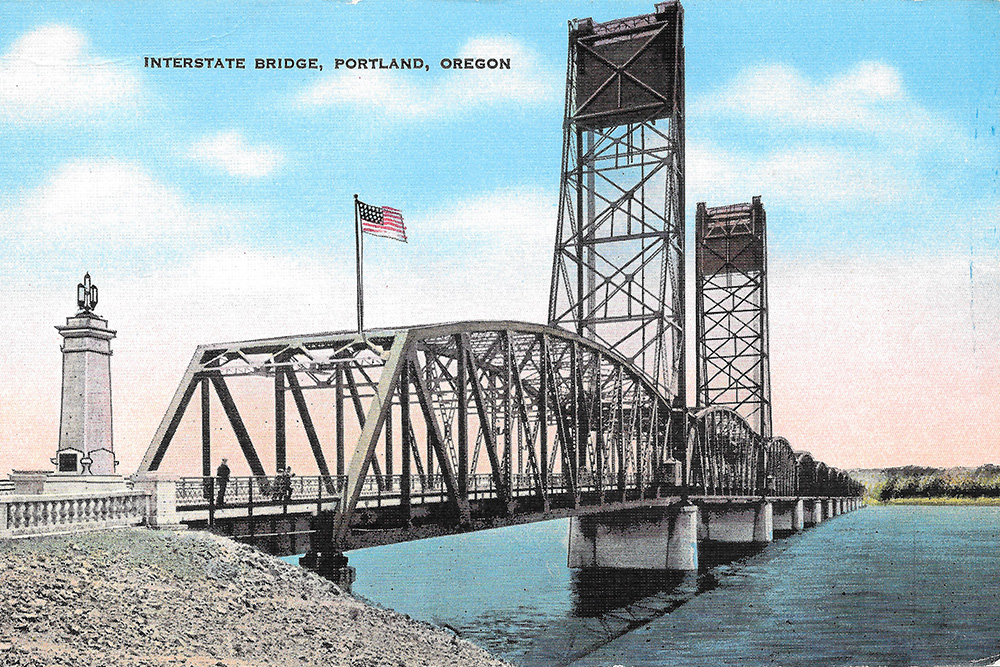
Postcard details: Full color, linen postcard, no border, divided back, unused
1917 Interstate Bridge
The original Interstate Bridge opened February 14, 1917, relieving an over-burdened ferry system on the Columbia River. The bridge cost $1,749,000 to build, coming in under budget by $1000. When it opened it was a single bridge carrying two-way traffic. Street cars used the bridge from its opening until 1940.
Read the whole story… History of the Interstate Bridge.
1958 Interstate Bridge
A second, almost identical bridge, was built next to the original bridge and opened July 1, 1958. The original 1917 bridge now handles the northbound traffic while the 1958 bridge handles the southbound traffic. The bridge pair is a nearly identical vertical-lift, “Parker type” through-truss bridge. As of 2006, about 130,000 vehicles cross the pair of bridges daily.
1894/1926 – Burnside Bridge
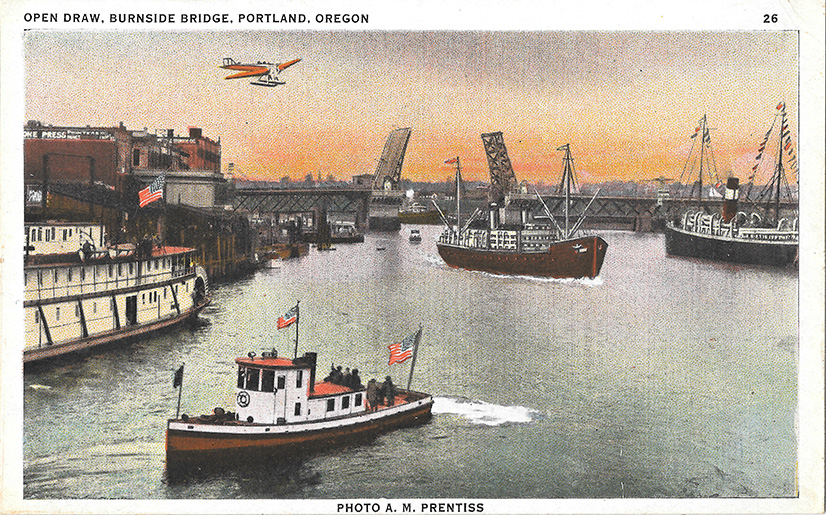
Postcard details: white border, divided back, “Post Card”, domestic, 1 cent stamp, unused,
published by Rose City News Co, Portland, Or
The Burnside Bridge you see today was the second Burnside Bridge built on the site.
1894 – Burnside Bridge
Opening to the public on July 4, 1894, the original Burnside Bridge was made of wrought iron and steel and was a swing-span truss bridge. Instead of lifting a bridge section vertically for boats to pass, a swing-span bridge rotates horizontally until it is parallel with the river allowing marine traffic to pass by.
1926 – Burnside Bridge
The current Burnside Bridge opened to the public on May 28, 1926 and cost $4.5 million to build. Oddly enough, it was the first Willamette River bridge in Portland to be designed by an architect. It is a Strauss-type double-leaf bascule bridge, which uses a system of counterweights, gears and motors to rotate the bridge leaves up and back. It’s located on one of the city’s busiest streets and has about 40,000 vehicles passing over it each day. Streetcars crossed the bridge until 1950.
1931 – St. Johns Bridge
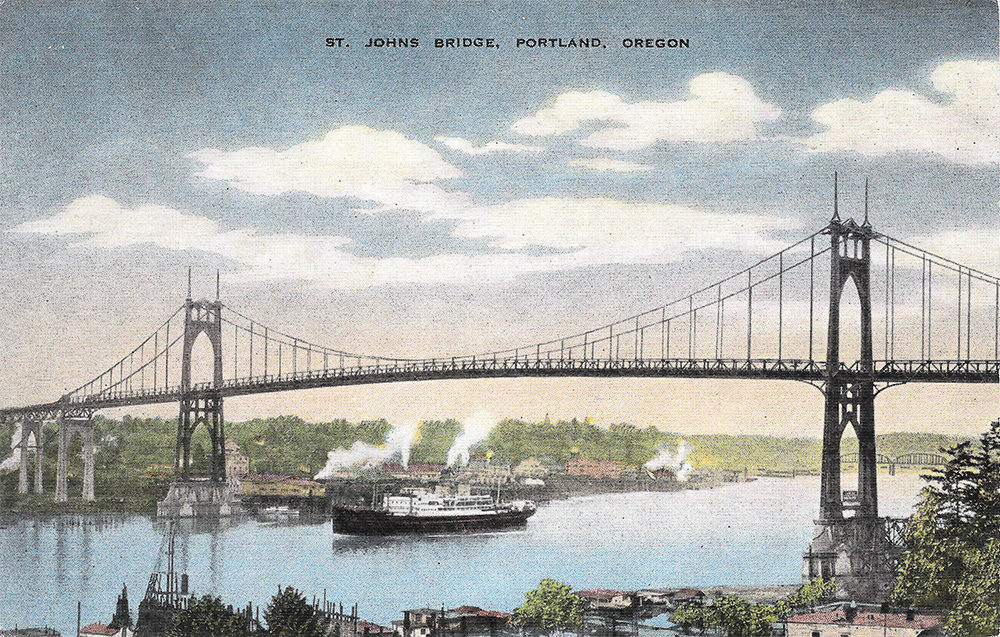
Postcard details: Full color, no border, linen postcard, divided back, no postage requirement, unused
Opening to the public on June 13, 1931, the St. Johns Bridge cost $4.5 million dollars to build. During construction, it was the longest suspension-type bridge west of the Mississippi. With it’s two 400-foot Gothic Cathedral inspired towers, it’s the tallest bridge in Portland and the only steel expansion bridge in the Willamete Valley. The bridge relieved a ferry that carried 1,000 vehicles a day. In 2017, 18,300 vehicles crossed the bridge daily.
